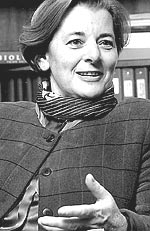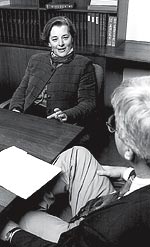Interview: Adrienne Clarke

Australia is home to an extraordinary number of world leaders in botanical and agricultural research, and Adrienne Clarke is one of the most prominent of these Australian plant biologists. In fact, as chairman of the CSIRO board, the national agency for science and technology, Dr. Clarke is one of Australia's most influential scientists. I traveled to Australia to interview Dr. Clarke in her office at the University of Melbourne, where she is Professor of Botany. Professor Clarke arrived for the interview from a meeting with top Australian government officials, so it seemed timely for me to begin by asking her about CSIRO and its national importance.
What is CSIRO, and what is its mission?
CSIRO stands for the Commonwealth Scientific and Industrial Research Organization. It is the main government body that does research for the benefit of Australia. We do scientific research related to the main economic sectors of the country, primarily mining, energy, and agriculture. We also do a lot of research on environmental problems. As our economy is changing from the traditional base of agriculture and mining, manufacturing is becoming more important, so we are putting more emphasis into some aspects of manufacturing technology and information technology.
What are your responsibilities as chairman of the CSIRO board?
As the chairman of the board, my responsibility is to report to government on the research activities of the organization in relation to the governing act of Parliament and a set of ministerial guidelines. The board is drawn from the community and like most boards its role is to set policy, to hire (and fire) the chief executive (through the minister), to monitor the progress of the organization, and to make sure that the financial reporting and the achievements of the organization are consistent with the government's goals.
Is your work as chairman of the CSIRO board politically sensitive?
Well, because we are a government-funded organization to a large extent—70% of our budget comes from the government-and we report to the government, there is clearly a political component to my role.
Would you say that scientists and politicians approach problems differently?
Yes, I think they do. They are under different pressures and are from different backgrounds. The scientists, very comfortable with acknowledging that they do not know something, can say, "Well, I don't know what the answers are," and then set about systematically acquiring the knowledge to solve the problem. On the other hand, it is often difficult for politicians to admit an ignorance. They are often under enormous time pressures to come up with some decision, and they are subject to bombardment from various interest groups that are often competing. I think politicians and scientists have to understand each other's culture and try to come to grips with working productively together.
In addition to your position with CSIRO, you also direct the Plant Cell Biology Research Centre at the University of Melbourne. What are the research objectives of this group?
The Plant Cell Biology Research Centre is one of the original special research centers that was set up by the Australian government. In this center we study two related fundamental questions in biology: how plants recognize and resist fungal infection, and how plants fertilize themselves or other plants. If you look at flowers, you will see that many have the female part, the pistil, very closely pressed to the male part, the anther. If the flowers were left to their own devices, the sperm in the pollen from a particular plant would fertilize the female in that same plant. This would lead to inbreeding and inbreeding depression, so very early in evolution plants devised a way of ensuring outcrossing that would make the female recognize and reject the male from the same plant—a mechanism of self-incompatibility. How the plant can distinguish self from nonself is a very fundamental question in plant biology. Not only does it tell us something about how plants achieve fertilization, it also tells us more broadly about how plant cells recognize each other.
In animals, cells are recognized as being self or nonself (foreign) by the immune system. Humans have a circulating blood system with white blood cells that can recognize and reject foreign material. We basically understand how recognition of foreign materials happens in the animal system, but we have very little idea at all of how it happens in plants. By understanding how a plant recognizes self and nonself pollen, we will get some insight into how plants recognize and reject other foreign invaders such as fungi and other pathogenic organisms.
 What is the genetic basis for self-incompatibility? How does a plant distinguish self and nonself?
What is the genetic basis for self-incompatibility? How does a plant distinguish self and nonself?
We don't know the full answer yet, but working with plants in the tomato family (such as tomato, tobacco, and potato), we found a single genetic locus with multiple alleles that controls self-incompatibility. This gene—the S gene (for self-incompatibility)—directs the secretion of a glycoprotein (a sugar joined to a protein) into the cells of the pistil. This is the pistil tissue through which the pollen tubes must grow to reach the ovules and fertilize eggs. As the pollen tubes grow on their way down to the ovary, they are bathed with the glycoprotein. We isolated the glycoprotein, cloned the gene, and found, very interestingly, that it is a ribonuclease—that is, it has an enzymatic function to degrade RNA. We believe that it acts as a toxin to self pollen. What happens is that RNAase is taken up from the female tissues into the male pollen tube. If it is a self-incompatible situation—if the pollen and pistil have matching alleles for the S gene—we can see that the ribosomal RNA of the pollen is degraded. Pollen, unlike most other tissues and cells, is not able to make more ribosomal RNA. When pollen is produced, it has all the ribosomal RNA it is ever going to have. Once it's gone, the pollen can no longer produce proteins, and growth of the pollen tube grinds to a halt.
The missing link in all of this, the part we don't understand yet, is the nature of the product of the S gene in pollen and what controls the specificity. How is it that the RNAase from the pistil tissue destroys RNA in self pollen but not in non-self pollen? It is a very hot topic, and there are many labs around the world working on it now.
What impact is biotechnology having on agriculture?
A particularly important impact of biotechnology would be in the area of disease and insect resistance in plants. There is huge pressure in this area to reduce the use of chemicals. There is a lot of interest in using biotechnology to engineer plants to produce natural toxins, for instance, so that the use of pesticides and other chemicals can be reduced.
What influenced you to become a scientist?
I grew up on a farm, and I think the rural experience influences a lot of people to become scientists. In the bush, we're observers of the natural world from an early age. I went to a small girls' school, and we didn't have much in the way of science teaching. However, I had one very inspirational teacher who taught me math and physics. She also did a wonderful thing. She took a band of teenage girls, including myself, on a trip to the Barrier Reef, and there I saw a whole new world under the water. I was astounded at the diversity of the forms and the colors. I also found I was good at science. I did well, got scholarships, and wanted to go on.
And what attracted you to your research specialty of plant cell biology?
I started in the field of plant carbohydrate chemistry, and the initial attraction was the people I knew I would be working with. For me, the environment is as important as the work itself. When you start on a scientific project, it is usually going to last for several years, and you want to feel very comfortable with the people you are working with. First of all, they have to have a professional skill that you admire, and second, they have to be nice people. I think you have to feel comfortable, you have to feel happy with what you do.
You continue to be a strong voice for the value of teamwork in science. Why do you think this is so important?
I think that science has now, in many areas, become so complex. The biggest problems you tackle, which are the ones that will make an impact, require different skills and different technologies. You have to build a team because no one person can have all those technologies under their belt. For instance, we might have a physical chemist working on the flow properties of a gum thickener for the food industry. That physical chemist will also need to know what this material is made of, so there's a need for an analytical chemist. And if the material comes from a plant, then a plant biologist should be part of the team. There are all sorts of examples of those situations. You need multidisciplinary teams to tackle big problems.
Why do you think women are still underrepresented in scientific careers?
As I see it, it is often the conflict between biological destiny and a career pathway that doesn't allow for people to be out of the work force at some time. I struggled with this. When I came back to Australia after several years in America in 1963, I was pregnant with my third child, and I said, "So, I will be a mother now." I cleaned out the cupboard and got all these research papers together and threw them in the fire. As I saw the flames leaping, I changed my mind. Luckily, I was able to save the papers in time. One of the things that we have done at the University of Melbourne is to ensure that women who are talented and enthusiastic in their careers may have part-time work or time out to have a baby.
What advice do you have for students who are considering careers in science?
My advice is that if you do the basic training in science, you can then branch off to do all sorts of things. For young women considering futures in science, it's important to understand that it is possible, with some difficulty, to have a family and have a satisfying career too. This will become less difficult as our social structure continues to change and men take more of a role in household and child-rearing duties. There are also tremendous opportunities opening up now for people with combinations of skills—science with accounting, science with law, science and engineering, and a whole range of combinations in science and technology. I would say that if women are interested in science careers, they should do it. As our structures are changing, it is very much easier both to pursue a career and to raise a family than it was back when I was doing it.
©2005 Pearson Education, Inc., publishing as Benjamin Cummings